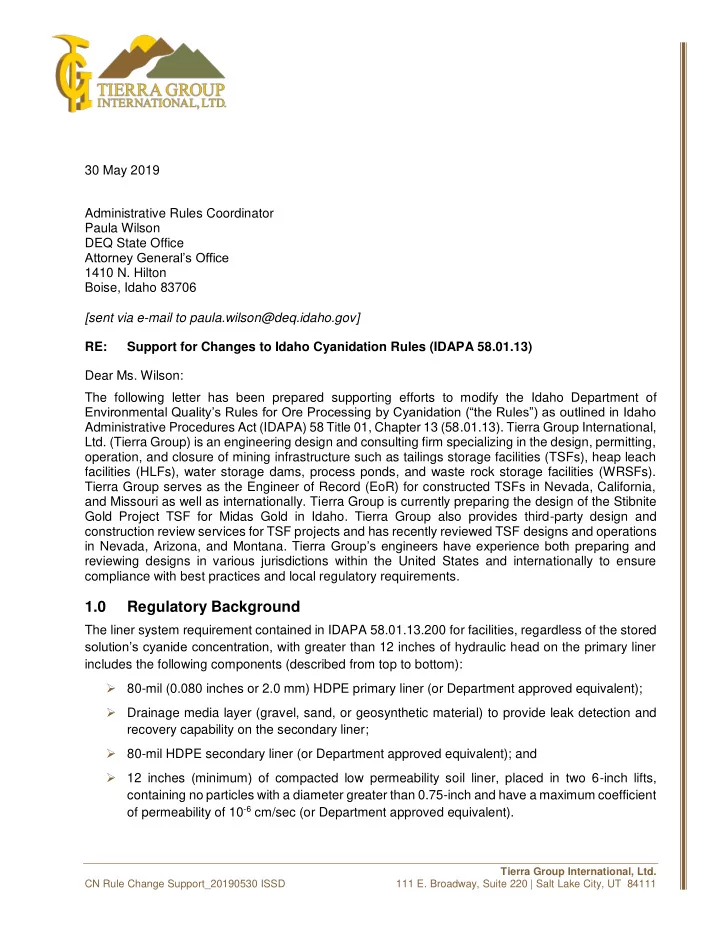

30 May 2019 Administrative Rules Coordinator Paula Wilson DEQ State Office Attorney General’s Office 1410 N. Hilton Boise, Idaho 83706 [sent via e-mail to paula.wilson@deq.idaho.gov] RE: Support for Changes to Idaho Cyanidation Rules (IDAPA 58.01.13) Dear Ms. Wilson: The following letter has been prepared supporting efforts to modify the Idaho Department of Environmental Quality’s Rules for Ore Processing by Cyanidation (“the Rules”) as outlined in Idaho Administrative Procedures Act (IDAPA) 58 Title 01, Chapter 13 (58.01.13). Tierra Group International, Ltd. (Tierra Group) is an engineering design and consulting firm specializing in the design, permitting, operation, and closure of mining infrastructure such as tailings storage facilities (TSFs), heap leach facilities (HLFs), water storage dams, process ponds, and waste rock storage facilities (WRSFs). Tierra Group serves as the Engineer of Record (EoR) for constructed TSFs in Nevada, California, and Missouri as well as internationally. Tierra Group is currently preparing the design of the Stibnite Gold Project TSF for Midas Gold in Idaho. Tierra Group also provides third-party design and construction review services for TSF projects and has recently reviewed TSF designs and operations in Nevada, Arizona, and Montana. Ti erra Group’s engineers have experience both preparing and reviewing designs in various jurisdictions within the United States and internationally to ensure compliance with best practices and local regulatory requirements. 1.0 Regulatory Background The liner system requirement contained in IDAPA 58.01.13.200 for facilities, regardless of the stored solution’s cyanide concentration, with greater than 12 inches of hydraulic head on the primary liner includes the following components (described from top to bottom): ➢ 80-mil (0.080 inches or 2.0 mm) HDPE primary liner (or Department approved equivalent); ➢ Drainage media layer (gravel, sand, or geosynthetic material) to provide leak detection and recovery capability on the secondary liner; ➢ 80-mil HDPE secondary liner (or Department approved equivalent); and ➢ 12 inches (minimum) of compacted low permeability soil liner, placed in two 6-inch lifts, containing no particles with a diameter greater than 0.75-inch and have a maximum coefficient of permeability of 10 -6 cm/sec (or Department approved equivalent). Tierra Group International, Ltd. CN Rule Change Support_20190530 ISSD 111 E. Broadway, Suite 220 | Salt Lake City, UT 84111
Administrative Rules Coordinator 30 May 2019 Page 2 of 6 2.0 Idaho Cyanidation Rules Observations Tierra Group supports the intent of the Rules, which is to “establish requirements for water quality protection which address performance, construction, operation and closure of that portion of any cyanidation facility that is intended to contain, treat, or dispose of process water.” In addition, the Rules are ”intended to ensure that process water and process -contaminated water generated in ore processing operations that utilize cyanide as a primary leaching agent and pollutants associated with the cyanidation process are safely contained, controlled, and treated so that they do not interfere with the beneficial uses of the waters of the state and do not endanger public safety or the environment.” Tierra Group offers the following observations: ➢ The Rules do not differentiate between different types of cyanide storage facilities (i.e. TSFs, HLFs, or process ponds) and the nature of the material (hydraulic characteristics) being stored in direct contact with the liner system when assigning required design components. Facilities are differentiated in both Nevada regulations and in Arizona’s Aquifer Protection Permit (APP) program in which both prescriptive Best Available Demonstrated Control Technology (BADCT) design parameters (requirements differentiated between precious and base metal operations) and individual (or site- and facility-specific) design parameters may be proposed for use; ➢ The Rules do not account for the concentration of cyanide in the process water being stored in the facility; and ➢ Certain prescriptive measures may have the unintended consequence of increasing the risk of release and potential impacts. A leak detection layer with high hydraulic conductivity between the primary and secondary synthetic liners in TSFs with more than one foot of hydraulic head on the primary liner may reduce the level of protection provided by the liner system over the TSF’s life because the conductive layer creates a hydrologic connection between potential leaks in the primary liner with any leaks in the secondary liner. 2.1 Facility Differentiation When assessing potential leakage from a lined facility, the nature of the material being stored above the liner system is extremely important and will impact the overall performance of the liner system. The following is offered as a brief comparison: ➢ TSFs, as the name implies, store tailings produced during the milling of ore. The tailings are generally very fine-grained (sand-, silt-, and clay-sized particles) and exhibit a very low hydraulic conductivity (ability to transmit water). Very often, the consolidated fine-grained tailings at the base of a TSF in direct contact with the liner system, will exhibit a saturated hydraulic conductivity less than 1x10 -6 centimeters per second (cm/sec). The very low hydraulic conductivity of the tailings provides an additional protective measure against leakage from the TSF through any liner defects, as process water cannot be efficiently delivered to the defect due to the low hydraulic conductivity of the tailings overlying the liner; ➢ A HLF stores either run-of-mine or crushed ore on lined containment. A cyanide solution is then sprinkled on the stacked ore to liberate gold from the ore transporting it (in solution) through the stacked ore and collected at the base of the facility (above the liner). Above liner collection systems, that typically include a combination of pipes and gravel-sized material, capture the gold-bearing solution. High hydraulic conductivity of heap leach ore needs to be maintained to allow solution to be applied and (more importantly for the operator) recovered Tierra Group International, Ltd. CN Rule Change Support_20190530 ISSD 111 E. Broadway, Suite 220 | Salt Lake City, UT 84111
Recommend
More recommend